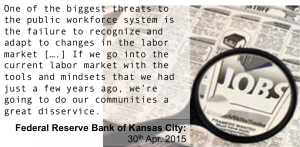[ezcol_2third]
 How could workforce boards, philanthropies and charities respond to Irregular Work? Might Britain’s projects help catalyse thinking?
How could workforce boards, philanthropies and charities respond to Irregular Work? Might Britain’s projects help catalyse thinking?
Ahead of the curve
Demand for low skilled-labor is fragmenting. Even someone in a job is now often on irregular hours, seeking top-up employment when not required. This became a problem for the British government early on (because of impact on our welfare regime). We explored small-scale solutions but realized a worker-focused marketplace was required.
In the US, this kind of stabilizing service is likely to start at city or state level. Getting a market working in a first location would create a demonstrable roadmap for everyone else. But that first city or state will bear disproportionate costs and uncertainty around launch. That’s why philanthropies willing to innovate could be crucial. They could assist a first area testing a model that could then be replicated elsewhere.
British technologies and learning now sits in the not-for-profit Beyond Jobs program. We plan to open source the software so anyone can launch, amend, improve or test it. This could create a standard set of components that any city can vary.
We are starting an informal design group for managers thinking through issues around Irregular Work at this level of labor markets. It aims to stay in periodic contact with a range of people who might eventually contribute to development of markets for the US.
The group
The group is low key, made up of people interested in monitoring our work and possibly making use of it when the time is right. Participants agree to:
- Take a call every 3 months to check on evolving thinking/actions around Irregular Work
- Receive a monthly email update on progress from our end
- Offer any insights as a first city moves towards launch
- Be available for occasional cross-fertilization, for example; many philanthropies are often not attuned to the role workforce boards play in local labor markets. A call can put it in context.
Members can leave at any time. Membership is confidential, by invite (we do not have resources to handle public interest at this point).
Who moves first?
Any location could be right to pioneer a new model of Irregular Work under local control. A successful first launch in the US requires: (a) a block of bookings for irregular workers totalling at least $2.3m over a first year (b) funding to Americanize the technology.
 We can provide a manual: “How to launch a market”. It outlines a structured project that: (a) explores local sources of bookings (b) models a first year of market activity (c) involves necessary stakeholders (d) builds a business case for launch.
We can provide a manual: “How to launch a market”. It outlines a structured project that: (a) explores local sources of bookings (b) models a first year of market activity (c) involves necessary stakeholders (d) builds a business case for launch.
Broadly, 3 months work by a resourceful Project Manager should identify any easily identifiable routes to local launch. If there are none, that preliminary exploration can lay the ground for more detailed research.
We are working to identify funding for a central project that supports a first successful pilot launch. In the meantime, it may be that funding could be found locally. The easiest way to start a city or state wide market for Irregular Work is probably to incorporate it in an existing project that includes spend on contingent labor.
For example: a city allocates $5m over 2 years to clean up unsightly public areas and wants opportunity youth to do the work. By spending on local people through a new market, those young workers can then be quickly booked – on their own terms – by multiple other employers. That expanding activity then allows the market to be opened to further work seekers, which makes the exchange increasingly useful to all employers. A spiral of growth can start.

If you know of additional contacts who might be interested in our design group, please let us know.
→ Home
[/ezcol_2third] [ezcol_1third_end][/ezcol_1third_end]

